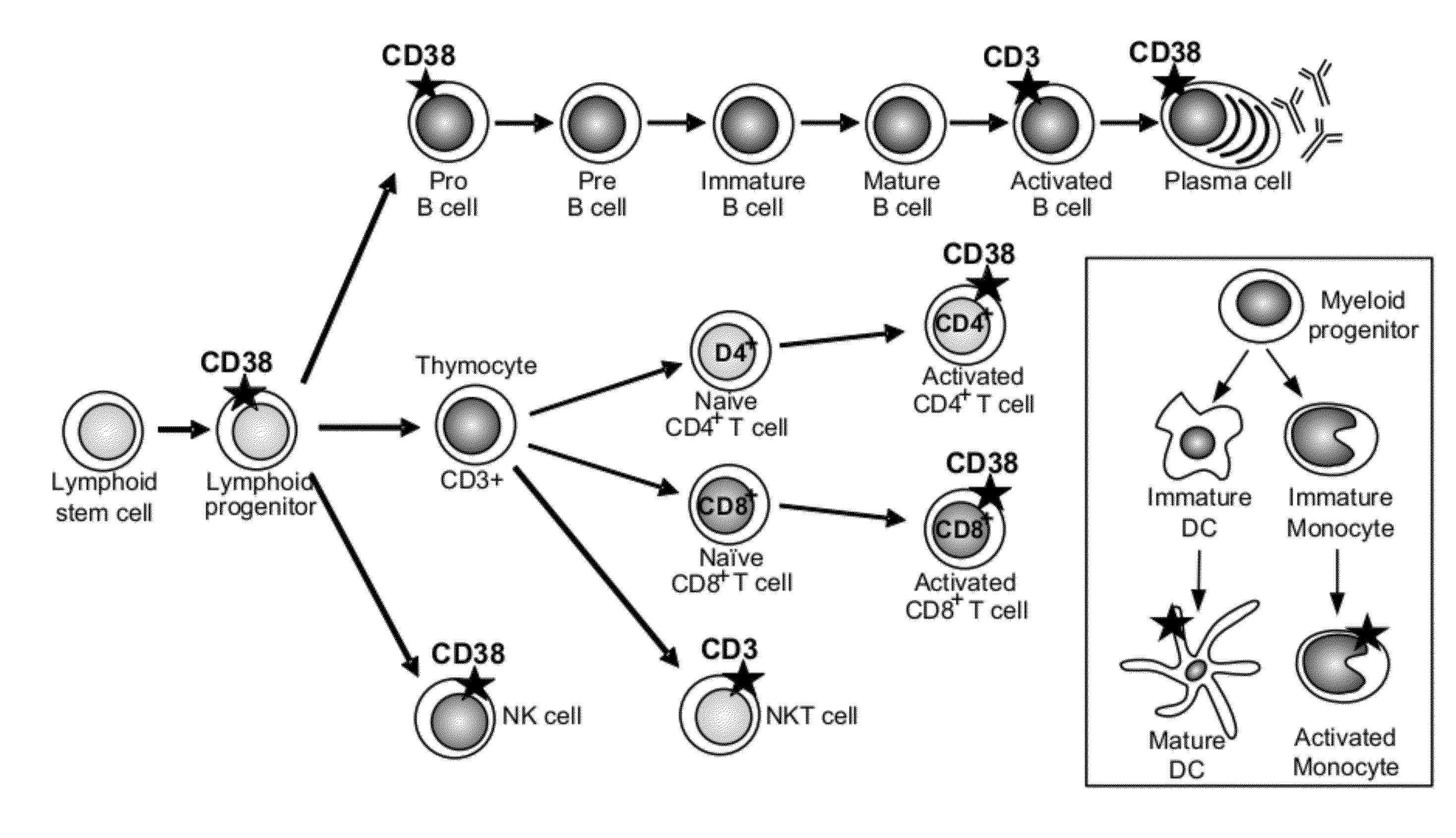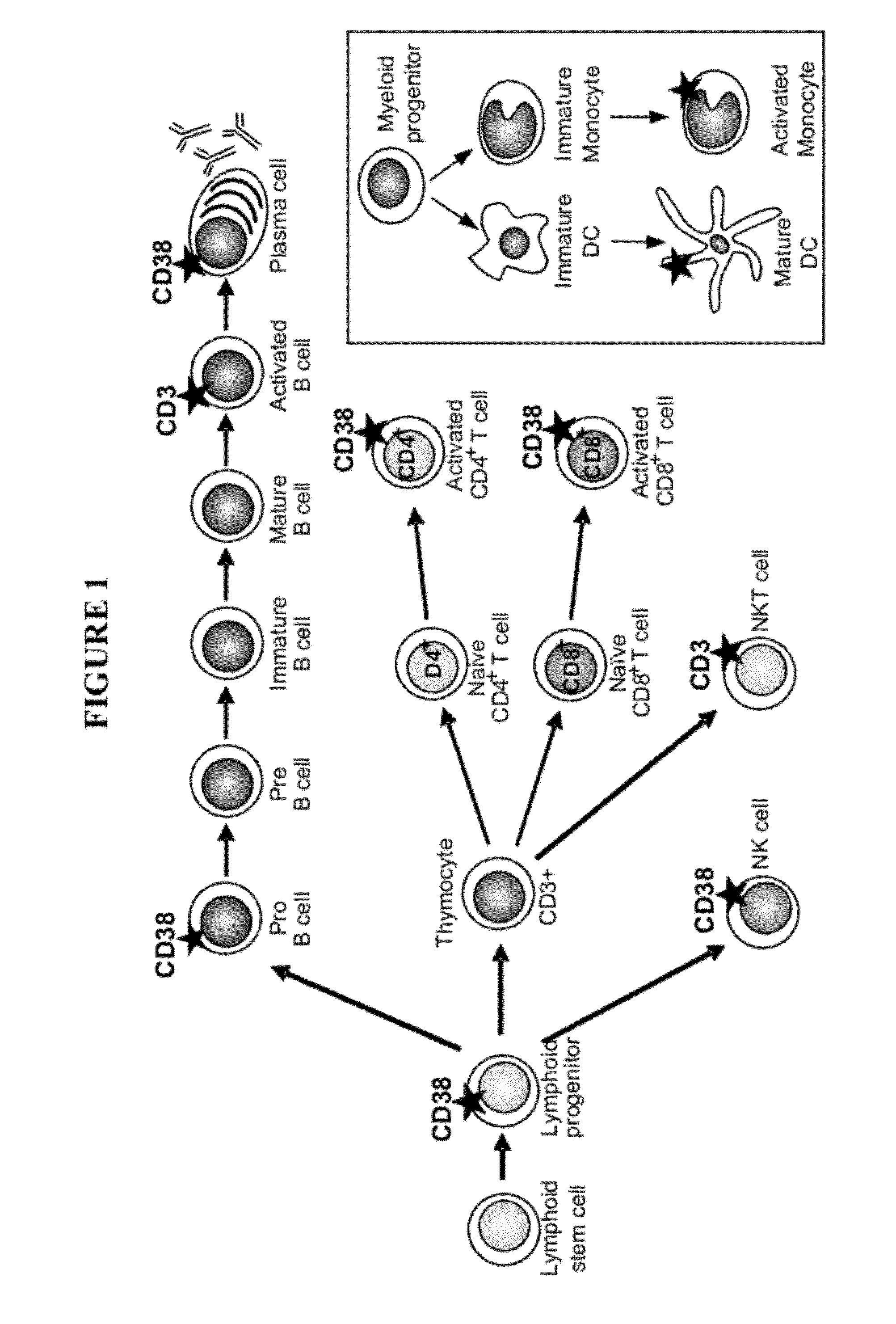Anti-cd38 antibodies
a technology of anti-cd38 and anti-tumor, which is applied in the field of anti-cd38 antibodies, can solve the problems of incomplete loss of that function, many forms of cancer involving cd38-expressing tumors still have a poor prognosis, and exhibit a defect in their innate immunity and a reduced humoral respons
- Summary
- Abstract
- Description
- Claims
- Application Information
AI Technical Summary
Benefits of technology
Problems solved by technology
Method used
Image
Examples
example 1
Construction of Expression Vectors Comprising Polynucleotides Encoding Human, Cynomolgus Monkey, and Mouse CD38
[0236]To construct a vector expressing human CD38 (huCD38), a polynucleotide encoding huCD38 was isolated from cDNA obtained from Origene Technologies Trueclone® human. The isolated huCD38 was cloned into a stable expression vector (XOMA, Inc.) containing the neomycin resistance (neoR) gene, which allowed for the selection of G418 (Geneticin)-resistant transfectants. The huCD38 gene present in the selected transfectants was sequenced to identify any sequence errors. Errors in the sequence that deviated from Genbank accession NM—001775 were corrected by PCR site-directed mutagenesis. The final vector DNA was confirmed by 5′ sequencing.
[0237]To construct a vector expressing cynomolgus monkey CD38 (cyCD38), a polynucleotide encoding cyCD38 was isolated from DNA obtained from Biochain Institute's cDNA-monkey (cynomolgus)-normal spleen tissue. The isolated cyCD38 was cloned into...
example 2
Development of CD38 Expressing Chinese Hamster Ovary (CHO) Cells
[0239]For development of CHO cells expressing huCD38, muCD38 and cyCD38, CHO cells were transfected with linearized DNA. After one week under selection, the cells were sorted by flow cytometry and the highest huCD38, muCD38 or cyCD38 expressing cells (top 15%) were plated in 96-well plates to generate single colonies. The remaining cells were also plated under selection to generate backup colonies. Approximately 12-14 days after plating, single colonies were identified and transferred to 96-deep-well plates. Clones were screened by FACS analysis after the second passage. Top producing clones were passaged and expanded to shake flasks. The top 2 clones were frozen and / or cultured for mycoplasmal AVA testing and scale-up.
[0240]To construct a luciferase reporter for disseminated xenograft models, a commercial vector containing the CMV promoter / luciferase gene / neomycin selectable marker (Promega, Madison, Wis.) was used to ...
example 3
Phage Display Libraries and Screening of Agents that Bind CD38
[0241]Selection of target specific antibody from a phage display library was carried out according to methods described by Marks et al. (2004, Methods Mol. Biol. 248:161-76). Briefly, the phage display library was incubated with 100 pmols of biotinylated CD38 at room temperature for 1 hr and the complex formed was then captured using 100 μL of Streptavidin bead suspension (DYNABEADS® M-280 Streptavidin, Invitrogen). Non-specific phages were removed by washing the beads with wash buffer (5% milk in PBS). Bound phages were eluted with 0.5 ml of 100 nM triethyleamine (TEA) and immediately neutralized by addition of an equal volume of 1M TRIS-CI, pH 7.4. The eluted phage pool was used to infect TG1 E. coli cells growing in logarithmic phase and phagemid was rescued as described in Marks et al., Id. Selection was repeated for a total of three rounds.
[0242]Alternatively, phage display libraries were panned against immobilized C...
PUM
| Property | Measurement | Unit |
|---|---|---|
| Molar density | aaaaa | aaaaa |
| Molar density | aaaaa | aaaaa |
| Molar density | aaaaa | aaaaa |
Abstract
Description
Claims
Application Information
 Login to View More
Login to View More - R&D
- Intellectual Property
- Life Sciences
- Materials
- Tech Scout
- Unparalleled Data Quality
- Higher Quality Content
- 60% Fewer Hallucinations
Browse by: Latest US Patents, China's latest patents, Technical Efficacy Thesaurus, Application Domain, Technology Topic, Popular Technical Reports.
© 2025 PatSnap. All rights reserved.Legal|Privacy policy|Modern Slavery Act Transparency Statement|Sitemap|About US| Contact US: help@patsnap.com



